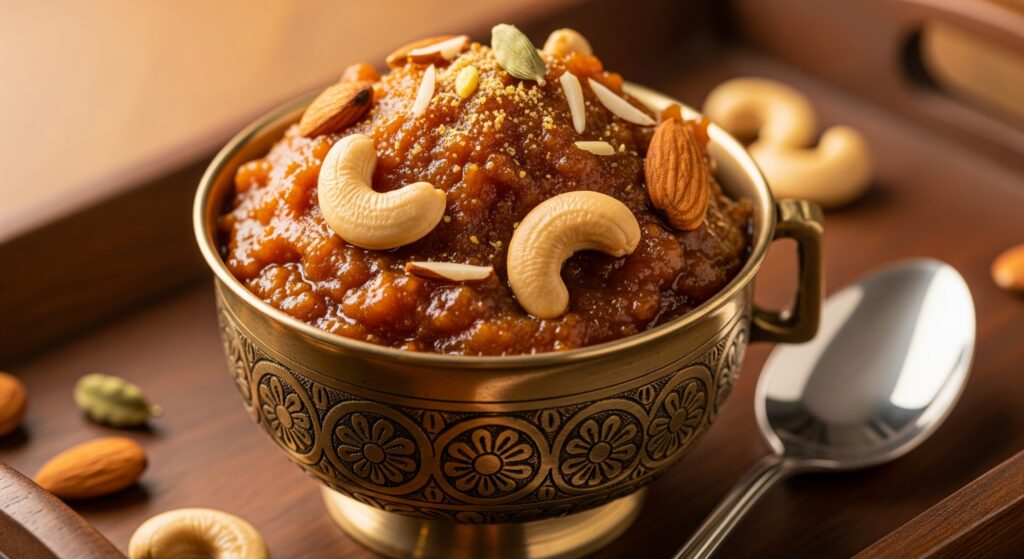Navratri is one of the most celebrated Hindu festivals in India, observed with great devotion and enthusiasm. This nine-day festival is dedicated to the worship of Goddess Durga, who symbolizes power and purity. During Navratri, many people observe fasting as a way to purify their body and mind, seeking blessings from the Goddess. Fasting is not just a religious practice but also an opportunity to detoxify the body and renew one’s spiritual energy.
To me, Navratri is not only about devotion but also about tradition, culture, and the joy of food. Different regions of India have their own fasting rules and recipes, while North Indians often enjoy sabudana and kuttu, in South India people turn to fruits, milk, and special flours. This diversity is what makes Navratri fasting so unique.
I’m especially excited this year since 2025’s Sharad (autumn) Navratri falls from Monday, September 22 to Wednesday, October 1, with Vijayadashami on October 2.
The Importance of Maintaining a Nutritious Diet During Fasting
While fasting, it’s crucial to maintain a nutritious diet to stay energized and healthy throughout the day. Navratri fasting recipes are designed to provide essential nutrients while keeping the meals light and fulfilling. Fasting doesn’t mean starving; it’s about eating the right foods that provide energy, nourishment, and help maintain overall well-being. A balanced diet of Healthy Navratri dishes ensures that you remain active and focused on your prayers and daily activities. It also helps in avoiding fatigue, headaches, and other health issues that might arise from improper fasting practices.
Before I share the recipes, here’s a quick look at what’s usually allowed and avoided during Navratri:
- Allowed foods: Sabudana, Samak rice, Kuttu, Singhara flour, dairy products, fruits, makhana, dry fruits.
- Avoided foods: Wheat, rice, onion, garlic, table salt, pulses.
This list helps me stay mindful of what ingredients I can experiment with while preparing healthy fasting meals.
Healthy and Delicious Navratri Fasting Recipes
Here are some healthy and delicious dishes you can enjoy during Navratri fasting:
1. Sabudana Khichdi

-
- Ingredients: 1 cup sabudana (tapioca pearls), 2 medium potatoes (boiled and cubed), 1/4 cup roasted peanuts (coarsely ground), 2 green chilies (chopped), 1 tsp cumin seeds, salt (sendha namak), 2 tbsp ghee, fresh coriander leaves for garnish.
- Method:
- Soak the sabudana in water for 4-5 hours or overnight.
- In a pan, heat ghee and add cumin seeds. Once they splutter, add green chilies and potatoes.
- Sauté for a few minutes, then add the soaked sabudana, peanuts, and salt.
- Cook until the sabudana becomes translucent. Garnish with coriander leaves and serve hot.
- Nutritional benefit: Sabudana is rich in carbohydrates, giving you an instant energy boost during fasting.
2. Kuttu Ka Dosa

-
- Ingredients: 1 cup kuttu ka atta (buckwheat flour), 1/2 cup boiled mashed potatoes, 1/2 cup water, rock salt, ghee for cooking.
- Method:
- In a bowl, mix kuttu ka atta, mashed potatoes, salt, and water to make a smooth batter.
- Heat a non-stick pan, spread a ladle of batter like a dosa, and cook with ghee until golden brown on both sides.
- Serve with vrat ki chutney or curd.
- Nutritional benefit: Kuttu is packed with protein and fibre, helping in digestion and keeping you full for longer.
3. Samak Rice Pulao

-
- Ingredients: 1 cup samak rice (barnyard millet), 2 tbsp ghee, 1 tsp cumin seeds, 1/2 cup diced carrots, 1/2 cup peas, 1 medium potato (cubed), rock salt, water.
- Method:
- Wash and soak samak rice for 30 minutes.
- Heat ghee in a pan, add cumin seeds, and let them crackle.
- Add the vegetables and sauté for a few minutes.
- Add samak rice, salt, and 2 cups of water. Cook until the rice is soft and fluffy.
- Serve hot with curd or vrat chutney.
- Nutritional benefit: Samak rice is gluten-free and light on the stomach, making it a great grain substitute.
4. Singhare Ke Atte Ka Halwa

-
- Ingredients: 1 cup singhare ka atta (water chestnut flour), 1/2 cup ghee, 1/2 cup sugar, 2 cups water, a pinch of cardamom powder, chopped nuts for garnish.
- Method:
- Heat ghee in a pan and add singhare ka atta. Roast on low heat until golden brown and aromatic.
- In another pan, dissolve sugar in water and bring it to a boil.
- Slowly add the sugar syrup to the roasted flour, stirring continuously to avoid lumps.
- Cook until the mixture thickens and leaves the sides of the pan.
- Add cardamom powder and garnish with chopped nuts. Serve warm.
- Nutritional benefit: Singhara flour is rich in antioxidants and a natural cooling food for the body.
I also like to add a few more simple recipes to my Navratri menu, such as:
- Sweet Potato Chaat – a tangy and filling snack.
- Roasted Makhana – a crunchy, guilt-free evening munch.
- Makhana Kheer – a light, sweet dish perfect for celebrations.
- Paneer Tikka (vrat-friendly) – a protein-rich treat for dinner.
Essential Tips for a Healthy Navratri Fast
To make the most of your Navratri fasting experience, here are some essential tips to keep in mind:
- Hydrate Properly: Drink plenty of water, coconut water, or fresh fruit juices throughout the day. Proper hydration helps flush out toxins and keeps you energized.
- Eat Small Meals: Instead of having large meals, opt for smaller, more frequent meals to keep your energy levels stable. Include Fasting food for Navratri like fruits, nuts, and light meals to avoid overeating.
- Include Variety: Don’t stick to just one type of food. Mix and match different Healthy Navratri dishes to ensure you get a balanced intake of nutrients. Include ingredients like sabudana, kuttu, and singhara to add variety and nutrition.
- Avoid Fried Foods: While fried snacks might be tempting, they can make you feel sluggish and heavy. Opt for steamed, boiled, or lightly sautéed Navratri special recipes to maintain your energy and health.
Another tip that works for me is meal planning. I create a simple one-day vrat meal plan like this:
- Breakfast: Fruit bowl with dry fruits
- Mid-morning: Coconut water or buttermilk (with rock salt)
- Lunch: Samak rice pulao with curd
- Evening snack: Roasted makhana or sweet potato chaat
- Dinner: Kuttu dosa with vrat ki chutney, followed by makhana kheer
This way, I don’t end up overeating and still get a good balance of nutrients throughout the day.
Why Fasting Can Be Beneficial for Health
Fasting during Navratri is more than a religious observance; it also offers numerous health benefits when done correctly. Here’s why fasting can be good for your health:
- Detoxification: Fasting allows the digestive system to rest and helps in detoxifying the body by eliminating toxins. By following Navratri fasting recipes, you can cleanse your body while still nourishing it with essential nutrients.
- Improved Digestion: Eating light and easily digestible foods like fruits, sabudana, and kuttu helps improve digestion and prevents bloating and indigestion.
- Mental Clarity: Fasting can lead to improved focus and mental clarity, as it encourages mindful eating and spiritual practices. This mental clarity can help you connect more deeply with the spiritual aspects of Navratri.
- Weight Management: When done mindfully, fasting can help in managing weight, as it promotes portion control and reduces the intake of unhealthy, calorie-dense foods.
I personally feel the biggest benefit is mindfulness. When I fast, I slow down, focus on what I eat, and connect more deeply with the spiritual aspect of Navratri. It’s not just about giving up certain foods, but about cleansing the body and mind together.
Conclusion: The Importance of Maintaining a Healthy and Balanced Diet During Navratri Fasting
Fasting during Navratri is a time-honored tradition that allows for spiritual and physical cleansing. However, it is essential to ensure that the foods you consume during fasting are healthy, nutritious, and energy-boosting. Incorporating a variety of Healthy Navratri dishes like Sabudana Khichdi, Kuttu Ka Dosa, and Samak Rice Pulao in your diet not only keeps you full but also provides the necessary nutrients to stay active and focused. Navratri special recipes are designed to be light yet nutritious, ensuring that your fasting experience is both fulfilling and spiritually enriching.
For me, Navratri fasting is as much about family bonding and celebrating traditions as it is about health and devotion. When we prepare these recipes at home, it feels like we are not only nourishing our bodies but also feeding our souls.
Frequently Asked Questions (FAQs) About Navratri Fasting
1. What foods are allowed during Navratri fasting?
I usually eat foods like sabudana, samak rice, kuttu flour, singhara flour, makhana, paneer, fresh fruits, dry fruits, and dairy products. Rock salt (sendha namak) is used instead of regular table salt.
2. Can I drink tea or coffee while fasting?
Yes, you can. I prefer green tea or herbal tea as they feel lighter and are more hydrating. Coffee is allowed, but I avoid too much since it can dehydrate the body.
3. What snacks can I have if I feel hungry in between meals?
My go-to snacks are roasted makhana, dry fruits, fruit chaat, or a glass of coconut water. These keep me full without making me feel heavy.
4. How do I avoid fatigue during Navratri fasting?
I make sure to stay hydrated, eat small meals throughout the day, and include energy-rich foods like sabudana, sweet potato, and nuts. This keeps my energy levels stable.
5. Are fried foods okay to eat during fasting?
Technically yes, but I personally avoid them. Fried foods can make me feel bloated and sluggish. Instead, I go for roasted or lightly sautéed dishes.
6. Can Navratri fasting help with weight loss?
Yes, it can—but only if done mindfully. For me, it works when I stick to light, nutritious meals and avoid overeating fried or sugary vrat foods. It’s more about balance than restriction.
Read More:

